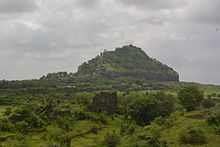Gavli
Gavli (also spelled as Gawli or Gavali) (Marathi: गवळी) is a Hindu caste in the Indian states of Maharashtra and Madhya Pradesh.[1][2][3] They are a part of the Yadav community.[4][5][6][7][8][9][10]
Etymology
[edit]The name Gauli may have been derived from a sanskrit word meaning cow.[11]
History
[edit]Origin
[edit]Some authorities have suggested that Ahirs (today Yadavs) migrated to Maharashtra from Punjab and Sindh in early historic times. other researchers have hypothesized that these people have inhabited Maharashtra for the last 5,000 to 10,000 years.[12]
Gavli are distributed all over Maharashtra. Although Reginald Edward has classified Gawlis as sub-caste of many different castes Ahir Gawli (sub-caste of famous Yadav caste of North India) whereas Hanbar Gawli, Singaji Gawli and Lingayat Gawli are different from Yadav-Ahir Gawli.[13][14][15] Along with Maratha and Kunbis, Ahir Gawlis are considered one of the allied castes of Maratha caste and have been included in the Maratha Regiment in the past.[16][17]
Relationship with Deccan Yadavas
[edit]
The Seuna Yadava dynasty, which ruled present-day Maharashtra and north Karnataka, arose out of the valorous deeds of Dridhaprahara, founder of the dynasty, who protected cattle. According to the traditional sources, Devagiri, the capital of Seuna Yadavas, was founded by a king who was a Golla/Gavli.[15][18][19] The idea that the Seunas were a Gavli dynasty survives to this day in folk traditions of the Nashik-Khandesh area, where they are traditionally called "Gavli Kings".[20][21] During the reign of Seuna Yadavas and their rival Hoysala Yadavas, the temple of Vitthal at Pandharpur, under their purview, grew from a small pastoral deity site to a major temple complex.[22]
References
[edit]- ^ Jaffrelot (2003), p. 187: "The term "Yadav" covers many castes which initially had different names: Ahir in the Hindi belt, Punjab and Gujarat, Gavli in Maharashtra, Gola in Andhra Pradesh and Karnataka etc."
- ^ Malhotra, K. C. (March 1982). "Ecology of a pastoral caste: Gavli Dhangars of peninsular India" (PDF). Human Ecology. 10 (1): 107–143. doi:10.1007/BF01531107. S2CID 154253698.
- ^ Mehta, B. H. (1994). Gonds of the Central Indian Highlands. Vol. II. New Delhi: Concept Publishing Company. pp. 568–569.
- ^ Saraswati, Baidyanath (1998). The Cultural Dimension of Ecology. Indira Gandhi National Centre for the Arts. ISBN 978-81-246-0102-0.
- ^ Tribes, Karnataka (India) Legislature Committee on the Welfare of Scheduled Castes and Scheduled. Report. Karnataka Legislature Secretariat.
- ^ Commission, Third Karnataka Backward Classes (1990). The Justice-journey of the Karnataka Backward Classes. Government of Karnataka.
- ^ Karnataka State Gazetteer: Shimoga. Director of Print., Stationery and Publications at the Government Press. 1975.
- ^ General, India Office of the Registrar (1962). Census of India, 1961. Manager of Publications.
- ^ Maharashtra State Gazetteers: Buldhana. Director of Government Printing, Stationery and Publications, Maharashtra State, 1976. 1976. p. 224.
- ^ Singh, K. S.; India, Anthropological Survey of (1998). India's Communities. Oxford University Press. ISBN 978-0-19-563354-2.
- ^ Ghurye, Govind Sadashiv (1969). Caste and Race in India. Popular Prakashan. p. 32. ISBN 978-81-7154-205-5.
- ^ Pearl, Raymond (1993). Human Biology. Wayne State University Press. p. 306.
- ^ Rao (1979), p. 129.
- ^ Enthoven (1990), p. 368.
- ^ a b Feldhaus (1989), p. 101.
- ^ Constable, Philip (2001). "The Marginalization of a Dalit Martial Race in Late Nineteenth- and Early Twentieth-Century Western India". The Journal of Asian Studies. 60 (2): 439–478. doi:10.2307/2659700. JSTOR 2659700. PMID 18268829. S2CID 40219522. Retrieved 2020-11-28.
- ^ Jaffrelot (2003), p. 163.
- ^ Wink (2001), p. 231.
- ^ Müller, Friedrich Max; Kultur-Referat, Germany (West) Botschaft India (1976). German Scholars on India: Contributions to Indian Studies. Chowkhamba Sanskrit Series Office.
- ^ Dhere (2011), p. 237,246,247.
- ^ Dhavalikar (2014), p. 274.
- ^ Novetzke (2016), p. 93.
Bibliography
[edit]- Guha, Sumit (2006). Environment and Ethnicity in India, 1200-1991. University of Cambridge. ISBN 978-0-521-02870-7.
- Rao, M. S. A. (1979). Social movements and social transformation: a study of two backward classes movements in India. Delhi: Macmillan. ISBN 9780333902554.
- Bayly, Susan (2001). Caste, Society and Politics in India from the Eighteenth Century to the Modern Age. Cambridge University Press. ISBN 978-0-521-79842-6.
- Jaffrelot, Christophe (2003). India's Silent Revolution: The Rise of the Lower Castes in North India. C. Hurst & Co. Publishers. ISBN 978-1-85065-670-8.
- Dhere, Ramchandra (2011). Rise of a Folk God: Vitthal of Pandharpur South Asia Research. Oxford University Press, 2011. ISBN 9780199777648.
- Hassan, Syed Siraj ul (1989). The castes and tribes of H.E.H. the Nizam's dominions. Asian Educational Services. ISBN 978-81-206-0488-9. Retrieved 2011-07-25.
- Enthoven, R. E. (1990). The Tribes and Castes of Bombay, Vol 1. Asian Educational Services. ISBN 9788120606302.
- Dhavalikar, Madhukar (2014). Socio-economic Archaeology of India. Archaeological Survey of India, 2014.
- Rao, M. S. A. (1972). Tradition, rationality, and change: essays in sociology of economic development and social change. Popular Prakashan.
- Novetzke, Christian Lee (2016). The Quotidian Revolution: Vernacularization, Religion, and the Premodern Public Sphere in India. Columbia University Press. doi:10.7312/nove17580. ISBN 9780231542418.
- Lukacs, John (2001). The People of South Asia: The Biological Anthropology of India, Pakistan, and Nepal. Springer. ISBN 9781489950031.
- Feldhaus, Anne (1989). Sontheimer, Gunther-Dietz (ed.). Pastoral Deities in Western India. Oxford University Press. ISBN 9780195055009.
- Wink, Andre (2001). Nomads in the Sedentary World. Routledge (Taylor and Francis Group). ISBN 9780203037201.
